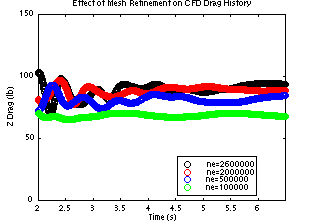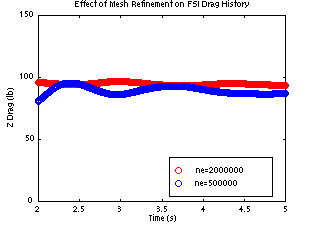| Source | Average Drag (lbs) | |
|---|---|---|
| Sim. Type | Num. Elements | Drag |
| CFD | 100000 | 69.4 |
| CFD | 500000 | 78.9 |
| CFD | 2000000 | 84.9 |
| CFD | 2600000 | 90.3 |
| CFD Wide Domain | 44.1 | |
| Parks Wind Tunnel | 44 | |

Actual average drag, defined by
Drag=(1/2)*Cd*rho*V2*A,
can be predicted from the model average drag by equating drag coefficients,
thus using the relationship
Drag=Dragm*(rho/rhom)*(V/Vm)2.
Values from the actual wind tunnel test and from the model simulation are given below:
ActualAcanopy = 5 ft2
rhoair = 0.00237
V = 58.6 ft/s
ModelAcanopy-m = 5 ft2
rhoair-m = 1.0
Vm = 1.0 ft/s
Average drag was calculated using results from both the CFD simulation and the FSI simulation.
Values for average drag calculated from CFD simulations of four different mesh refinements, as well as for average drag calculated from the wide domain CFD simulation, are shown below. The value for average drag calculated from the Parks wind tunnel tests is also shown.
|

|
||||||||||||||||||||||||
|---|---|---|---|---|---|---|---|---|---|---|---|---|---|---|---|---|---|---|---|---|---|---|---|---|---|
Shown above at right is a plot of drag histories for the four CFD simulations of differing mesh refinements. The histories show similar trends, and again demonstrate that drag appears to converge with increased mesh refinement.
Values for average drag calculated from FSI simulations of two different mesh refinements, as well as for average drag calculated from the wide domain FSI simulation, are shown below. The value for average drag calculated from the Parks wind tunnel tests is also shown.
|

|
||||||||||||||||||
|---|---|---|---|---|---|---|---|---|---|---|---|---|---|---|---|---|---|---|---|
Shown above at right is a plot of drag histories for the two FSI simulations of differing mesh refinements. The histories show similar trends, and due to the similarity of the FSI drag histories with the CFD drag histories, it is guessed with confidence that were more FSI simulations to be conducted with higher mesh refinements, convergence to some value of average drag would be seen.